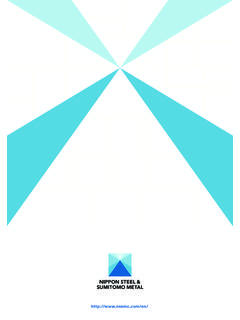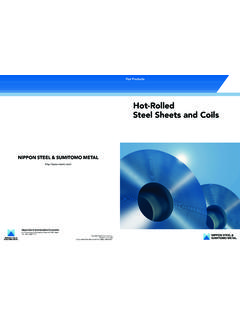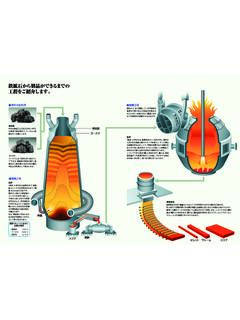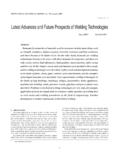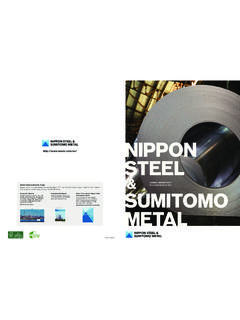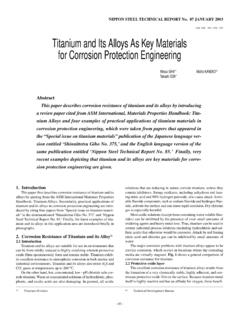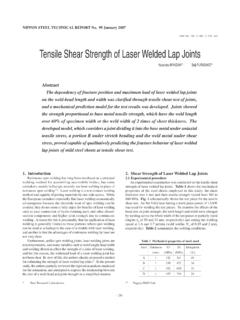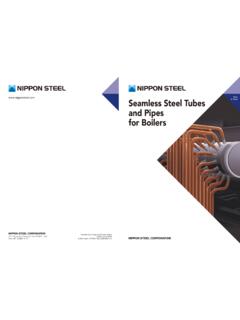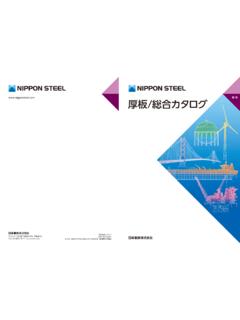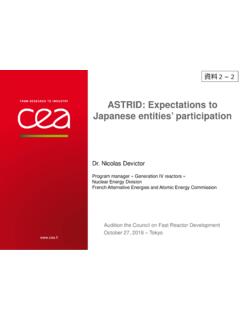Transcription of Technical Report Residual Stress Measurement of …
1 NIPPON STEEL Technical Report No. 100 JULY 2011. UDC 539 . 419 : 621 . 791 . 763 . 1 : 539 . 125 . 5. Technical Report Residual Stress Measurement of welding Area by Neutron Diffraction Method Tamaki SUZUKI* Masaaki SUGIYAMA. Hatsuhiko OIKAWA Tetsuro NOSE. Muneyuki IMAFUKU Yo TOMOTA. Hiroshi SUZUKI Atsushi MORIAI. Abstract Resistance spot welding technique is extensively applied to join the body steel sheets in the manufacturing process for the automobile industry. It is known that the fa- tigue crack initiates occasionally inside of the spot-welded zone in this material, which is a serious issue of the fatigue life. Although this phenomenon is supposed to be related to internal Residual Stress , the actual Residual Stress distribution inside of the spot-welded zone is not clear up to now.
2 In this study, a neutron diffraction Residual Stress Measurement technique with well-defined sub-mm3 square gauge volume is applied in order to clarify the internal three dimensional Residual Stress distribution just below the spot-welded part of the steel sheets. the other direction was widened to ensure sufficient signal strength. 1. Introduction The minimum gauge volume was about 1 mm3. In order to understand the phenomenon of fatigue fracture of a Recently, the resistance spot welding technique, as well as nug- steel structure, especially in its welded joints, understanding the re- get joints, is applied to the many parts of an automobile to join the sidual Stress distribution in welded joints is indispensable. In order body steel sheets. Fatigue is one of the problems of the spot welding to measure the Residual Stress distribution, a nondestructive method technique.
3 With the conventional method of measuring the Residual using X-rays, synchrotron radiation, or neutrons is generally applied. Stress in welded joints using a cut specimen, however, the problem In the case of a steel material, not a light metal, ordinary X-rays can of Stress relief cannot be ignored. Ordinarily, in resistance spot weld- penetrate a few tens of m at most. Synchrotron radiation a high- ing, the steel sheets to be joined together are pressed from both sides. energy X-ray can penetrate several mm;1) however, because of its Therefore, any Residual Stress in the welded joints is expected to be lower angle of incidence, the measuring region elongates in one di- anisotropic. In addition, there are cases in which a fatigue crack or rection, calling for a larger gauge volume.
4 Accordingly, neutron dif- Stress propagation and diffusion occur in the nugget. For the reasons fraction, which affords higher penetration, is considered a promising mentioned above, establishing a technique to measure the Residual technique to measure Residual Stress in a region several mm deep Stress in local regions has been demanded. from the surface of a steel material. Under such conditions, in the Research on Basic Study of Steel In contrast, in principle, it is difficult to narrow down the beam Evaluation Technology Utilizing Neutrons, etc. which forms part with the neutron diffraction method. To compensate for such diffi- of the Steel Research for Industry Reconstruction Project, equipment culty, an incident slit is used. In one example, an incident slit with improvements required to increase the speed and improve the accu- one direction narrowed down to mm was ) The other slit in racy of Residual Stress Measurement were discussed at the initiative * Senior Researcher, Materials Characterization Research Lab.
5 , Advanced Technology Research Laboratories 20-1, Shintomi, Futtsu, Chiba - 47 - NIPPON STEEL Technical Report No. 100 JULY 2011. of the Japan Atomic Energy Agency. As a result, a radial collimator and one-dimensional neutron detector were introduced. In the present study, we attempted to measure the Residual Stress in a spot-welded zone using the neutron diffraction method and the newly introduced collimator and detector. 2. Measurement of Stress using Neutron Diffraction Since neutrons carry no electrical charge, they do not interact with electrons in materials and can penetrate deep into any material. Neutrons penetrate even iron to a depth of several tens of mm. There- fore, they allow for nondestructive Measurement of the strain in steel materials. In the Measurement area of a material defined by incident slits and receiving slits as shown in Fig.
6 1, it is possible to determine the lattice plane spacing in a specific area by precisely measuring Fig. 2 Angular dispersive method the Bragg diffraction from a particular crystalline lattice plane. With the method of using neutrons to measure Stress , it is pos- sible to implement nondestructive Measurement of the Stress in a material. Therefore, it is widely used to measure the internal Stress of welded joints. It should be noted, however, that utilizing neutron beams requires a large-scale facility. In Japan, it is necessary to use one of the research reactors (JRR-3, J-PARC, etc.) of the Japan Atomic Energy Agency (JAEA). Stress Measurement techniques that utilize neutron diffraction can largely be divided into angular dispersive and time-of-flight meth- ods. In the angular dispersive method (Fig.)
7 2), a monochromator is used to obtain a neutron beam of a specific wavelength from a white neutron produced by a research reactor, etc. The neutron beam ob- tained is irradiated onto the specimen and the diffraction angle, 2 , Fig. 3 Time-of-flight method of the beam is measured. By so doing, the lattice plane spacing can be precisely measured. The JRR-3 reactor mentioned above is suit- able for this method. and then the Stress and strain are calculated from the difference be- In the time-of-flight method (Fig. 3), a pulsed white neutron ob- tween the calculated lattice plane spacing and the lattice plane spac- tained by an accelerator, etc. is irradiated directly onto the specimen ing under a Stress -free condition. and the lattice plane spacing is measured from the time of flight of the neutron with the angle formed by the incident neutron beam at 3.
8 Experimental Method the fixed detectors. The J-PARC reactor mentioned above is suitable In the experiment, we performed nondestructive Stress measure- for this method. ments by the neutron diffraction method using a diffractometer for When measuring Stress using neutrons, the angle of Bragg dif- Residual Stress analysis (RESA) at the JAEA. In the present study, fraction from a particular crystalline lattice plane is measured first we applied a one-dimensional position sensitive detector (PSD) that to accurately calculate the lattice plane spacing using Bragg's law had been introduced to improve the precision and increase the speed of measurements in the Steel Research for Industry Reconstruction Project. For the purposes of Stress Measurement , -Fe 211 diffrac- tion was used. The wavelength, , of the neutron beam used was approximately and the diffraction angle, 2 , was approxi- mately 90.
9 A slit was used as the incident slit, and a radial collimator was used as the receiving slit. Under those Measurement conditions, the gauge volume at the measuring position was set to be approximately mm3. As the steel material to be spot-welded, a thick mild steel (JSC270E). sheet was used. The yield point (YP) and tensile strength (TS) of the sheet obtained by tension Measurement were 139 MPa and 292 MPa, respectively. The spot welding conditions for the specimen are shown in Table 1. Residual Stress was measured in three directions, X, Y and Z, against the main axis of the material system and appropriate measur- ing points were set as required. For the three-way Measurement at each of the measuring points, a Euler cradle was arranged in such a manner that once it is set, it permits obtaining different diffracted Fig.
10 1 Gauge volume in strain scanning method beams from the same position. With the beam intensity used in the - 48 - NIPPON STEEL Technical Report No. 100 JULY 2011. Table 1 Spot welding conditions Electrode type Electrode force welding current welding time Hold time DR6 -40R Cr-Cu 16cycles 10cycles (50cycles =1s). present experiment, the measuring time was 100 minutes/point. 4. Experimental Results Cross-section structure In the experiment, several samples which were spot-welded un- der the same conditions were used. Using one of those samples, we observed the cross-section of the joint by an optical microscope. As a result, it was confirmed that the joint consisted entirely of ferrite and contained neither martensite nor pearlite. The average grain size of the portion away from the heat-affected zone (HAZ) was 25 m.
